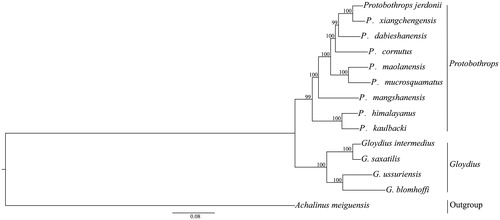Abstract
Protobothrops kaulbacki is a new record in China, and in this study, the complete mitochondrial genome sequence of P. kaulbacki had been determined. The length of mitogenome is 17,237 bp, including 13 protein-coding genes, 22 tRNA genes, 2 rRNA genes (12S and 16S rRNA), 1 origin of L-strand replication (OL), and 2 control regions (CRs). The maximum-likelihood (ML) tree based on the whole mitogenome shown that P. kaulbacki belongs to the genus Protobothrops.
Kaulback’s pitviper, Protobothrops kaulbacki is a kind of venomous snakes, belonging to the genus Protobothrops of family Viperidae. This species was firstly reported by Malcolm A. Smith in 1940, and found in Pangnamadim, north of Burma (Smith Citation1940). In 2004, Kaulback’s pitviper was collected by biologists during the Herpetological survey, and this was a new record in China (Rao & Zhao Citation2005). Therefore, nine species are currently recognized in China within the genus Protobothrops: P. maolanensis, P. jerdonii, P. xiangchengsis, P. cornutus, P. kaulbacki, P. mangshanensis, P. mucrosquamatus, P. himalayanus, and P. dabieshanensis (Yang et al. Citation2011; Huang et al. Citation2012; Pan et al. Citation2013). Because of less information for this genus, we need more molecular data and genome research for the P. kaulbacki.
The P. kaulbacki samples were collected in Mêdog County of the Southern Xizang, China (N 29°19′, E 95°10′) in August 2004. Presently, the specimen was stored in the Museum of Shenyang Normal University (Rao & Zhao Citation2005). We chose muscle tissue to extract the whole genomic DNA by a standard proteinase-K/phenol–chloroform protocol (Sambrook & Russell Citation2006). The entire mitogenome was amplified by polymerase chain reaction (PCR) using 20 primers. Here, we sequenced the complete mitochondrial genome of P. kaulbacki and deposited in GenBank (Accession number KY695463).
The complete mtDNA of P. kaulbacki is 17,237 bp in length, and the gene order was identical to P. dabieshanensis (Huang et al. Citation2012), including 13 protein-coding genes, 22 tRNA genes, 2 rRNA genes (12S and 16S rRNA), 1 origin of L-strand replication (OL), and 2 control regions (CRs). The base composition of the mitogenome was 33.3% A, 29.7% C, 12.3% G, and 24.7% T. The ND6 subunit gene, OL, and eight tRNA genes (tRNAPr°, tRNAGln, tRNAAla, tRNAAsn, tRNACys, tRNATyr, tRNASer(UCN), and tRNAGlu)) were encoded on the L-strand, the remaining genes were encoded on the H-strand. The control region1 (CR1) of the P. kaulbacki mtDNA is 1043 bp long and lies between the tRNAThr and tRNAPhe genes, while the control region2 (CR2) is 1067 bp long, between the tRNAPr° and tRNALeu(UUR) genes. The origin of L-strand replication (OL) in P. kaulbacki was inside a cluster of five tRNA genes (tRNATrp, tRNAAla, tRNAAsn, tRNACys, and tRNATyr), which is 34 bp long, as seen in most vertebrates.
The maximum-likelihood (ML) tree were generated with RAxML 7.0.3 (Stamatakis Citation2008) based on the whole mitogenome, Achalinus meiguensis was selected as an outgroup. In this process, the optimal substitution model (GTR) was implemented via JModelTest 2 (Darriba et al. Citation2012). As shown in , the phylogenetic tree were split into two well-supported major clades, the Protobothrops and the Gloydius, what’s more, P. kaulbacki is closer to P. himalayanus, belong to the genus Protobothrops.
Figure 1. The maximum-likelihood (ML) tree based on the whole mitogenome. Numbers at the nodes are bootstrap values of the ML analysis. The GenBank accession number of species are P. jerdonii (NC_021402), P. xiangchengensis (KF460436), P. dabieshanensis (KF003004), P. cornutus (NC_022695), P. maolanensis (NC_026051), P. mucrosquamatus (KT447436), P. mangshanensis (NC_026052), P. himalayanus (NC_029165), P. kaulbacki (KY695463), G. intermedius (NC_025560), G. saxatilis (NC_025666), G. ussuriensis (NC_026553), G. blomhoffi (NC_011390), A. meiguensis (NC_011576).

Because of the unique characteristics of mitochondrial DNA, mitochondrial genome sequences have been proven to play a significant role in phylogenetic relationships. We expect the present result to provide fundamental resources during analyzing the phylogenetic relationship within P. kaulbacki and other species in Viperidae.
Acknowledgements
We sincerely thank Guiyou Wu, Heng Zhang, and Lei Zhou for their help in this study.
Disclosure statement
The authors report no conflict of interest. The authors alone are responsible for the content and writing of the paper.
Additional information
Funding
References
- Darriba D, Taboada GL, Daollo R, Posada D. 2012. jModelTest 2: more models, new heuristics and parallel computing. Nat Methods. 9:772.
- Huang X, Pan T, Han DM, Zhang L, Hou YX, Yu L, Zheng HM, Zhang BW. 2012. A new species of the genus Protobothrops (Squamata: Viperidae: Crotalinae) from the Dabie Mountains, Anhui, China. Asian Herpetol Res. 3:213–218.
- Pan H, Chettrl B, Yang D, Jiang K, Wang K, Zhang L, Vogel G. 2013. A new species of the genus Protobothrops (Squamata: Viperidae) from Southern Tibet, China and Sikkim, India. Asian Herpetol Res. 4:109–115.
- Rao DQ, Zhao EM. 2005. A new record from China-Protobothrops kaulbacki (Reptilia, Squamata, Viperidae). Acta Zootaxon Sin. 30:209–211.
- Sambrook J, Russell DW. 2006. Purification of nucleic acids by extraction with phenol: chloroform. CSH Protoc. 2006. Available from: http://dx.doi.org/10.1101/pdb.prot4455
- Smith MA. 1940. Amphibians and reptiles from Upper Burma. Rec Indian Mus. 42:485–486.
- Stamatakis A. 2008. The RAxML 7.0.3 Manual. Heidelberg: Exelixis Lab, Heidelberg Institute for Theoretical Studies.
- Yang JH, Wang YY, Orlov NL. 2011. A new species of pit viper of the genus Protobothrops from China (Squamata: Viperidae). Zootaxa. 2936:59–68.
